The Acer Predator Triton 500 Laptop Review: Going Thin with GeForce RTX 2080
by Brett Howse on April 25, 2019 8:00 AM ESTWireless
For networking, Acer has turned to Killer Networking for both the Gigabit Ethernet, as well as the wireless adapter. The Acer Predator Triton 500 features the Killer Wireless-AC 1550, which is based on Intel’s excellent 9260 Wi-Fi solution, and the Killer E3000 Ethernet adapter. The big change over Intel’s previous 826x wireless is that the 9260 card offers support for 160 Mhz channels, meaning there is a peak theoretical speed of 1.73 Gbps with the 2x2:2 offering, but you’ll need a new access point with wide channel support to get this. In fact, we don’t even have an access point yet with this kind of capability, and even if you did, it runs into issues with what else is connected – most Ethernet is still going to be maxed out at Gigabit.
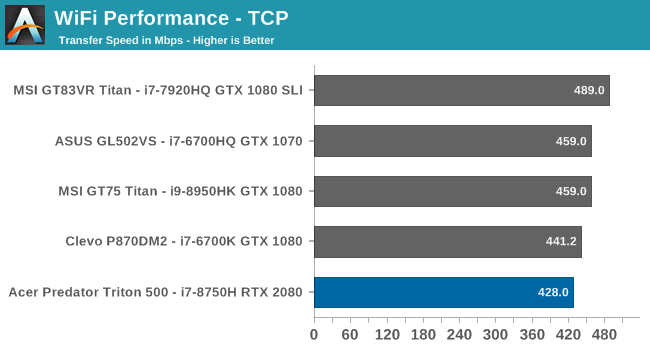
Performance on the 80 Mhz channels was only average, but if you do need more than the wireless offers, the wired Ethernet is available, or you can combine both with Killer’s DoubleShot Pro software, which can send some traffic over the slower connection to keep your lowest latency network free for gaming. It’s not likely something that is necessary most of the time, but it’s available if needed.
The main advantage of the Killer 1550 though is that being based on Intel’s rock solid wireless networking solution, Killer also gets the benefit of very stable drivers. Over the last couple of years, Intel has walked away with the wireless market, offering the fastest, and most stable networking around. Killer made a wise move partnering with Intel for their latest wireless products.
Audio
Acer offers Waves MaxxAudio for software defined equalization, and it also includes Waves Nx for positional audio, for faux 3-D. The software offers a full graphic EQ as well as some acoustic adjustments to change the bass response, detail, and sound stage width. The speakers actually sound decent considering how thin the laptop is, and there is excellent stereo separation. Bass response is much better than many laptops, and the overall volume level can go up to about 80 dB(A) measured one inch over the trackpad.
For headphones, Acer offers separate 3.5 mm headphone and microphone jacks, and when using headphones the Waves Nx is available for 3D positional audio. The amount of effect can be adjusted in the software, and while it does make 2D audio seem wider than 3D, it can also be disabled if you prefer a more natural sound.
Thermals
The biggest challenge for any gaming laptop is how to deal with the massive amounts of heat generated by modern CPUs and GPUs when gaming, and that is doubly true on thin and light models such as the Acer Predator Triton 500. Acer has approached the problem with some smart engineering and some brute force.
The Triton 500 leverages three fans based on fourth generation AeroBlade 3D Technology, which has a serrated edge to maximize airflow and reduce noise. The three fans tie into five heat pipes, and Acer has crafted large intake and exhaust vents into the rear and sides of the laptop to allow as much air as possible to be moved through the chassis.
The cooling system is also tied to Acer’s PredatorSense software, where you can adjust the fan speeds to suit your tastes, leave them on Auto, or enable CoolBoost which puts all of the fans at 100% speed.
To see how well Acer did, Shadow of the Tomb Raider was run at 1920x1080 with the highest settings.
The fans were left on Auto for the first portion of the test, and you can see that the GPU settles in quickly at about 80°C, running at an average of 1289 MHz. That’s significantly down on the maximum boost levels of a desktop card, which can hit 1710 MHz, or 1800 Mhz if it’s a Founder’s Edition, but the desktop card has a 215-Watt TDP. NVIDIA doesn’t announce the exact TDP of its laptop cards, likely because they are in a range, but the Triton 500 only ships with a 180-Watt AC Adapter, so some simple math removing 45 Watts for the CPU, some for the rest of the system, and a bit of spare, and the Max-Q design is likely under 120 Watts. Near the end of the test, the Turbo feature was enabled which spun the fans up to maximum and overclocked the GPU. You can see the temperatures instantly start to drop, and the GPU is able to ramp up a bit with the extra headroom, hitting an average of 1436 Mhz over this part of the test. Temperatures dropped to 76°C at the same time.
So even though the GPU has a much lower TDP than the desktop card, it’s still able to achieve a lot of its performance, thanks to the exponential nature of transistors. Power goes up at the square of voltage, so the final bit of voltage needed to hit the high frequencies comes at the biggest cost.
The Predator Triton 500 does a good job cooling itself, but it does come at the expense of noise, and this is where the bigger, thicker desktop replacement machines have a big advantage. They can offer this same cooling with larger, thicker fans, allowing them to move more air with less noise. At idle, the fans are running most of the time, and aren’t too intrusive, measuring about 40 dB(A) one inch over the trackpad. On Auto settings during this extended run, the noise was 53.6 dB(A) which is definitely headphone territory. With CoolBoost enabled, the sound level jumped to 59 dB(A), which is quite loud.
Acer offers overclocking on the Predator Triton 500, and if you’re into loud cooling, Acer does make it easy to get a few extra frames per second using their Turbo button.
Software
Acer ships the Predator Triton 500 with Windows 10 Home, and a handful of other software. Some of it is good, and some of it is terrible. On a $500 machine, margins are tight enough where you could maybe justify some of the crapware, even though everyone hates it. But on a $3000 high-end PC there’s no room for this, and Acer should simply cut it out.
Let’s start with the good though. The Acer PredatorSense software is well layed out, looks great, and offers a lot of functionality. You can not only adjust the lighting and cooling, but also do overclocking here, and get some excellent system level monitoring for temperatures and usage. Acer also offers GameSync so you can tie specific settings to games, so when you launch a game the system automatically changes the settings. I really like the layout and design here, and it looks quite modern.
Acer also offers the standard Acer Care Center application which lets you quickly access support, and update drivers and firmware directly from the company. It’s the same software found on most, if not all, of their current lineup, and is well thought out and easy to use.
The bad though is really bad. Acer ships the laptop with Norton Antivirus, which of course comes with a trial period and then wants you to pay for a full-term subscription. We’re all pretty used to this, and you can uninstall it easily enough. But Acer also includes software called Acer Jumpstart which throws targeted spam into your notification center. While testing this laptop I got a popup warning recommending McAfee which was downright deceptive. The irony is of course Acer shipped the laptop with Norton already. Perhaps they shouldn’t be recommending even more antivirus. There’s also the “Acer Collection” which is a list of apps is a list of software from the store that they think you might want to buy. There is zero need for this.
Even Microsoft has gotten into the crapware game, so it’s hard to really fault Acer for doing this on some products, but if they want to keep their premium devices feeling premium, they don’t need to riddle them with junk software. Install the utilities that are specific and useful, and leave the rest off.


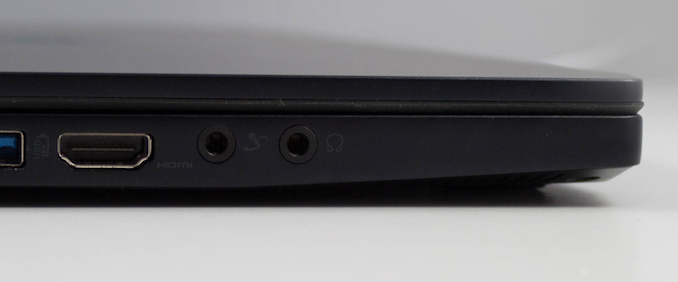
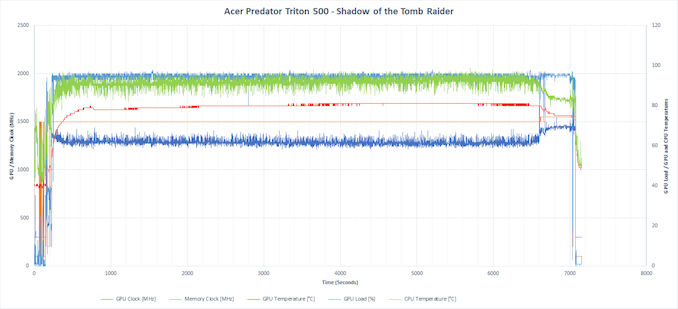


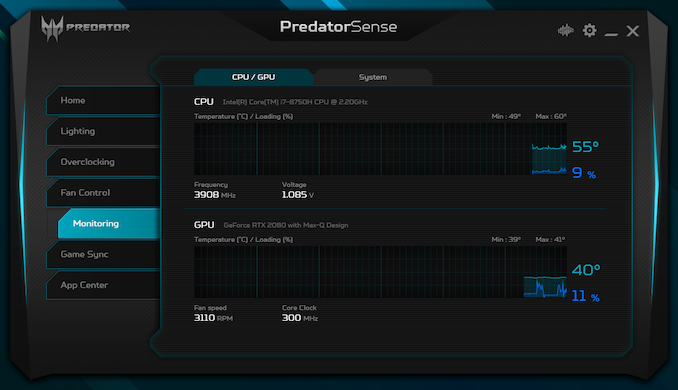

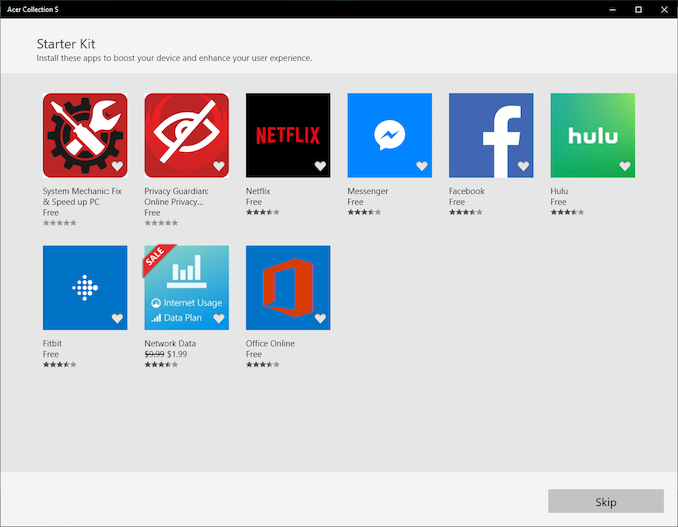








46 Comments
View All Comments
shabby - Thursday, April 25, 2019 - link
Is it really a 2080 when the base clock is cut in half?Daeros - Thursday, April 25, 2019 - link
No, but that's nvida's game - they can honestly say it's the same chip, even though performance is a few steps down in the hierarchy. Just like that 8750h's TDP is nowhere near 45w - probably closer to 120w under load.Opencg - Thursday, April 25, 2019 - link
you can see in the cpu benchmarks that draw real power for a significant portion of time that it loses a good deal of performance. all in all its about where it should be for a laptop this thin. i would be surprised if it is really designed to handle more than 45w. personally i would bet it can start to throttle on sustained 45w loadsphilehidiot - Thursday, April 25, 2019 - link
I saw the 2080 and then the screen resolution. In reality, you'd probably want 4K + gsync for a shortish lifespan machine or 1440P for one with a good few years on it. 1080P says the performance is compromised and they HAD to drop it down. You'd never ever run a desktop on a 2080 with 1080P. I bought a gaming laptop once when I had a real need for it, back in the P4 days. The thing had about 6 fans and chucked out 50C hot air. I required it at the time but I'd never buy one now unless I absolutely needed it. That had 1050 lines, so 1080 isn't really a step up, it's a marketing ploy ("FULL HD!")This GPU can not be considered alongside a real 2080 and whilst I appreciate the screen size means resolutions greater that 1440P would be silly (and arguably even that but you must remember you're usually closer to a laptop screen and even a 6" mobile can benefit from the upgrade from 1080 to 1440), to me a gaming laptop generally is 17" anyway. If you go down this path you're rarely looking for real portability but more because you (in my experience) live in two or three different places and want to take a full gaming PC with you with your suitcase and so on.
wintermute000 - Thursday, April 25, 2019 - link
Exactly, a 2060 would have been perfect for 1080p 144hz and then maybe the cooling would have coped.Must be a marketing decision to shove the biggest number into the spec sheet....
PeachNCream - Friday, May 3, 2019 - link
I would not mind the slightest pushing 1080p resolutions with a 2080 GPU, but not with this particular laptop given the network adapter selection. It just isn't worth messing with Killer NICs at all when there are other options out there.wintermute000 - Thursday, April 25, 2019 - link
a.) The TDP as defined by intel (i.e. base clock) IS 45W.b.) Power under boost is much higher for sure, but 120W is a total exaggeration. I can get it to run steady on 3.6Ghz (thermal throttling is a different question LOL) on around 60W with an undervolt.
3.) It would take a mean cooler and power delivery / VRMs on a laptop chassis to let it boost anywhere near its paper specs for long durations. I haven't looked at the built-like-a-tank laptops in depth but none of the mainstream designs have managed it so far.
wintermute000 - Thursday, April 25, 2019 - link
by it I mean the i7-8750H (in an XPS 9570 if that matters)Retycint - Saturday, April 27, 2019 - link
Intel's definition of TDP is very much meaningless because they can change the base clock to fit in the TDP envelope. The i7-8750H maintained the 45W TDP despite having 2 more cores than the 7700HQ, not because the former has had a huge leap in efficiency, but rather because Intel dropped the base clock from 2.8 to 2.2GHz.In other words, Intel can theoretically claim that the 9750H has a 10W TDP, when at the base clock of 0.8 GHz, for instance. Which is why TDP numbers are bull
jordanclock - Thursday, April 25, 2019 - link
Welcome to Max Q! Where the models are made up and the clocks don't matter!